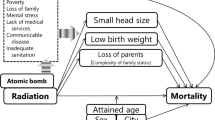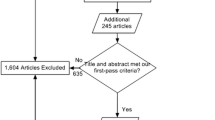Abstract
Objective
Exposure to radioisotopes of metals and halogen elements occurring in medical practice may cause spontaneous abortions. The potential role of occupational exposure to X-rays and internal radioisotopes on pregnancy outcome in childbearing age women employed in hospital departments were analyzed in order to estimate miscarriage risk.
Methods
Over a period of 16 years, the occurrence of miscarriages in 61 women exposed to radioisotopes was compared to that reported in 170 X-ray exposed women. Chromosomal aberrations (CA) were measured in both radiation-exposed groups and in 53 non-exposed women.
Results
Women exposed to radioisotopes experienced at least a threefold higher rate of spontaneous abortions than those exposed to X-ray (OR = 3.68, 95% CI = 1.39–9.74, P < 0.01). Although X-ray and radioisotopes exposed women had significantly higher levels of chromosome type frequency (0.51 ± 0.82, and 0.63 ± 0.99, respectively) than referents (0.17 ± 0.34), there was no clear difference between radiation-exposed women.
Conclusions
For exposure levels within standard recommended guidelines, radioisotopes are far more likely to play a role in the occurrence of spontaneous abortions than X-rays. Such biological effect is not detectable by deviations in CA frequency.
Similar content being viewed by others
References
Arbuckle TE, Lin Z, Mery LS (2001) An exploratory analysis of the effect of pesticide exposure on the risk of spontaneous abortion in an Ontario farm population. Environ Health Perspect 109(8):851–857
Auvinen A, Vahteristo M, Arvela H, Suomela M, Rahola T, Hakama M, Rytomaa T (2001) Chernobyl fallout and outcome of pregnancy in Finland. Environ Health Perspect 109(2):179–185
Bagchi D, Stohs SJ, Downs BW, Bagchi M, Preuss HG (2002) Cytotoxicity and oxidative mechanisms of different forms of chromium. Toxicology 180(1):5–22
Baghurst PA, Robertson EF, Oldfield RK, King BM, McMichel AJ, Vinpani GW, Wigg NR (1991) Lead in the placenta, membranes and umbilical cord in relation to pregnancy outcome in a lead-smelter community. Environ Health Perspect 90:315–320
Barber RW, Parkin A, Goldstein KE (2003) Is it safe to work with Iodine-131 if You are pregnant? A risk assessment for nuclear medicine staff involved with cleaning and decontamination. Nucl Med Commun 24(5):571–574
Brent R (1987) Relative radiosensitivity of fetal tissues. In: Lett JT (ed) Advances in radiation biology. Academic, Orlando, pp 239–256
Bridgewater LC, Manning FCR, Patierno SR (1998) Arrest of replication by mammalian DNA polymerases alpha and beta caused by chromium-DNA lesions. Mol Carcinog 23(4):201–206
Chatenoud L, Parazzini F, di Cintio E, Zanconato G, Benzi G, Bortolus R, LaVecchia C (1998) Paternal and maternal smoking habits before conception and during the first trimester: relation to spontaneous abortion. Ann Epidemiol 8(8):520–526
Correa A, Gray RH, Cohen R et al (1996) Ethylene glycol ethers and risks of spontaneous abortion and subfertility. Am J Epidemiol 143(7):707–717
Dantas FJ, De Mattos JC, Moraes MO, Viana ME, Lage CAS, Cabral-Neto JBL, Bernardo-Filho M, Bezerraa RJ, Carvalho JJ, Caldeira-de-Arujo A (2002) Genotoxic effects of stannous chloride (SnCl2) in K562 cell line. Food Chem Toxicol 40(10):1493–1498
Diggle PJ, Liang K, Zeger SL (1994) Analysis of longitudinal data. Oxford Statistical Science Series. Oxford University Press, New York
Doyle P, Roman E, Beral V, Brookes M (1997) Spontaneous abortion in dry cleaning workers potentially exposed to perchloroethylene. Occup Environ Med 54(12):848–853
Elbetieha A, Al-Hamood MH (1997) Long-term exposure of male and female mice to trivalent and hexavalent chromium compounds: effect on fertility. Toxicology 116(1–3):39–47
Gambelunghe A, Piccini R, Ambrogi M, Villarini M, Moretti M, Marchetti C, Abritti G, Muzi G (2003) Primary DNA damage in chrome-plating workers. Toxicology 188(2–3):187–195
Henriksen TB, Hjollund NH, Jensen TK, Bonde JP, Andersson AM, Kolstad H, Ernst E, Giwercman A, Skabzerback NE, Olsen J (2004) Alcohol consumption at the time of conception and spontaneous abortion. Am J Epidemiol 160(7):661–667
Himmelberger DU, Brown BW Jr, Cohen EN (1978) Cigarette smoking during pregnancy and the occurrence of spontaneous abortion and congenital abnormality. Am J Epidemiol 108(6):470–479
Hjollund NH, Bonde JP, Jensen TK, Hneriksen TB, Andersson AM, Kolstad HA (2000) Male-mediated spontaneous abortion among spouses of stainless steel welders. Scand J Work Environ Health 26(3):187–192
HSE -Health Safety Executive (2000) Work with ionising radiation. Ionizing Radiation Regulation 1999. Approved code of practice and guidance. HSE books series L, p 121
IAEA (1986) Biological dosimetry, chromosome aberration analysis for dose assessment. Technical report series no. 260. International Atomic Energy Agency, Vienna
ICRP International Commission on Radiological Protection (2001) Doses to the embryo and fetus from intakes of radionuclides by the mother. Annals of the ICRP, vol 31/1–3. ICRP Publication 88
International Commission on Radiologicalation Protection (2003) Report 90, biological effects after prenatal irradiation (Embryo and fetus), Pergamon, 33(no 1–2)
Kanojia RK, Junaid M, Murthy RC (1998) Embryo and fetotoxicity of hexavalent chromium: a long term study. Toxicol Lett 95(3):165–172
Kašuba V, Šentija K, Garaj-Vrhovac V, Fučić A (1995) Chromosome aberrations in peripheral blood lymphocytes from control individuals. Mutat Res 346:187–193
Kline J, Stein ZA, Susser M, Warburton D (1977) Smoking: a risk factor for spontaneous abortion. N Engl J Med 297(15):793–796
Lindbohm ML, Taskinen H (2000) Spontaneous abortions among veterinarians. Scand J Work Environ Health 26(6):501–506
Lindsey JK (1995) Modelling frequency and count data, Oxford Statistical Science Series. Oxford University Press, Oxford
Mahon DF, Subramaniam G, McAfee JG (1973) Experimental comparison of radioactive agents for studies of the placenta. J Nucl Med 14(9):651–659
McLean JR, Birnboim HC, Pontefact R, Kaplan JG (1983) The effect of tin chloride on the structure and function of DNA in human white blood cells. Chem Biol Interact 46(2):189–200
Mertz W (1986) Trace elements in human and animal nutrition, 5th edn, vol 2. In: Mertz W (ed) Academic, Orlando
Mountford PJ, Steele HR (1995) Fetal dose estimates and the ICRP abdominal dose limit for occupational exposure of pregnant staff to Techentium-99 m and iodine-131 patients. Eur J Nucl Med 22(10):1173–1179
NIOSH-National Institute for Occupational Safety and Health (2006) The registry of toxic effects of chemical substances. cdc.gov [homepage on the Internet], [cited 2006 Feb 16]. Available from: http://www.cdc.gov/niosh/rtecs/xp870a50.html
Phipps AW, Smith TJ, Fell TP, Harrison JD (2001) Doses to the embryo/fetus and neonate from intake of radionuclids by the mother. NRPB, Research report, p 397
Republic of Croatia (former Yougaslavia) (1986) Official Gazette, vol 40. 18 July 1986, pp 193–1195
Russell JR, Stabin MG, Sparks RB, Watson E (1997a) Radiation absorbed to the embryo/fetus from radiopharmaceuticals. Health phys 73(5):756–769
Russell JR, Stabin MG, Sparks RB (1997b) Placental transfer of radiopharmaceuticals and dosimetry in pregnancy. Health Phys 73(5):747–755
Schenker MB, Samuels SJ, Green RS, Wiggins P (1990) Adverse reproductive outcomes among female veterinarians. Am J Epidemiol 132(1):96–106
Schonfelder G, Wittfoht W, Hopp H, Talsness CE, Paul M, Chahaud I (2002) Parental bysphenol: a accumulation in the human maternal-fetal-placental unit. Environ Health Perspect 110(11):A703–A707
Shuhaiber S, Einarson A, Radde IC et al (2002) A prospective-controlled study of pregnant veterinary staff exposed to inhaled anesthetics and X-rays. Int J Occup Med Environ Health 15(4):363–373
Steele LL, Wilkins JR III (1996) Occupational exposures and risks of spontaneous abortion among female veterinarians. Int J Occup Environ Health 2(1):26–36
Streffer C, Van Beuningen D, Molls M (1978) Comparative effects of tritiated water and thymidine on the preimplanted mouse embryo in vitro. Curr Topics Radiat Res Q 12(1–4):182–193
Swan SH, Beaumont JJ, Hammond SK, VonBehren J, Green RS, Hallock MF, Woskie SR, Hinkes CJ, Shenker MB (1995) Historical cohort study of spontaneous abortion among fabrication workers in the semiconductor health study: agent-level analysis. Am J Ind Med 28(6):751–769
Takeda H, Nishimura Y, Inaba J (1994) Transfer of tritium to prenatal and neonatal rats from their mothers exposed to tritiated compounds. Rad Prot Dosimetry 53(1–4):281–284
Valanis B, Vollmer WM, Steele P (1999) Occupational exposure to antineoplastic agents: self-reported miscarriages and stillbirths among nurses and pharmacists. J Occup Environ Med 41(8):632–638
Von Zallinger C, Tempel K (1998) Trans-placental transfer of radionuclides: a review. Zentralbl Veterinarmed A 45(10):581–590
Wennborg H, Bodin L, Vainio H, Axelsson G (2000) Pregnancy outcome of personnel in Swedish biomedical research laboratories. J Occup Environ Med 42(4):438–446
Wibberley DG, Khera AK, Edwards JH, Rushton DI (1977) Lead levels in human placentae from normal and malformed births. J Med Genetics 14(5):339–345
Wisborg K, Kesmodel U, Henriksen TB, Hedegaard M, Secher NJ (2003) A prospective study of maternal smoking and spontaneous abortion. Acta Obstet Gynecol Scand 82(10):936–941
Xu X, Cho SI, Sammel M, You L, Cui S, Huang Y, Ma G, Padungdot C, Pothier L, Niu T, Christiani D, Smith T, Ryan L, Wang L (1998) Association of petrochemical exposure with spontaneous abortion. Occup Environ Med 55(1):31–36
Yamada T, Yukawa O (1984) In: Streffer C, Patrick G (eds) Effects of prenatal irradiation with special emphasis on late effects, Commission of the European Commission, Brussels, pp 5–17
Acknowledgment
JNL work support by NIH grant # 1 R43 CA117161-01 and DOD, contract #DAMD17-02-C-0008. AF and DFM work supported by EC contract #FOOD-CT-2005-016320 (NewGeneris).
Author information
Authors and Affiliations
Corresponding author
Additional information
The corresponding author has the right to grant on behalf of all authors and does grant on behalf of all authors, a non-exclusive license on a worldwide basis to the BMJ Publishing Group Ltd. and its Licensees to permit this article (if accepted) to be published in Occupational and Environmental Medicine editions.
Rights and permissions
About this article
Cite this article
Fucic, A., Merlo, D.F., Ceppi, M. et al. Spontaneous abortions in female populations occupationally exposed to ionizing radiation. Int Arch Occup Environ Health 81, 873–879 (2008). https://doi.org/10.1007/s00420-007-0281-1
Received:
Accepted:
Published:
Issue Date:
DOI: https://doi.org/10.1007/s00420-007-0281-1




